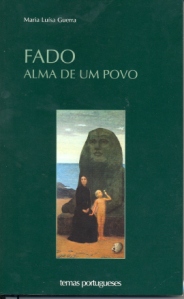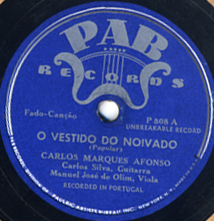Another oft-quoted introduction to fado’s ontology is a song made famous by Amália Rodrigues entitled ‘Tudo Isto É Fado’ [All of This Is Fado], in which the narrator initially claims not to know what fado is before going on to list a number of its features: ‘defeated souls, lost nights, bizarre shadows in the Mouraria’. The list continues as it leads to the famous refrain: ‘Amor, ciúme / Cinzas e lume / Dor e pecado / Tudo isto existe / Tudo isto é triste / Tudo isto é fado’ [Love, jealousy / Ashes and fire / Sorrow and sin / All of this exists / All of this is sad / All of this is fado.].
The song can be heard here. The full lyrics can be found here.
Sonically, the song provides as good an introduction as any to fado, opening with the distinctive tinkle of the guitarra, leading into the interplay between guitarra and viola (the Portuguese name for the Spanish guitar which is the other main accompanying instrument in fado) and providing an excellent example of Amália’s art as, within the space of the first short verse, she displays her famous melisma (‘perguntaste-me’) and hovers majestically on the word ‘fado’. The song, originally recorded by Rodrigues at Abbey Road in 1952, became one of those on which her reputation as the ‘queen of fado’ would rest.

Another example of fado’s desire to explain itself can be found in a book of poems entitled Fado, produced by José Régio in 1941. Its most famous poem ‘Fado Português’ recounts the maritime myth of fado’s origins, identifying the strong connection to the sea found in Portugal’s history and the loneliness of the mariner in the midst of the watery expanse. ‘Fado’, we are told, ‘was born … In the breast of a sailor / Who, feeling sad, sang’. Régio’s poem was, perhaps inevitably, set to music and became part of Amália’s repertoire. Amália’s version, with music by Alain Oulman, shortened and slightly reworded Régio’s original poem.
Amália’s version can be heard here. Régio’s poem can be found here.

The maritime myth is taken to arguably its greatest extreme in Maria Luísa Guerra’s Fado, Alma de um Povo [Fado, Soul of a People], in which the music is presented as an ‘existential cry’ born of the loneliness of the high seas. One of the reasons for the popularity of the maritime origin of fado is the connection to Portugal’s proud seafaring past and its significant colonial endeavours. While one searches in vain in narratives such as Guerra’s for any proof that what we know now as fado really owes its existence to these sailors, the connection to the sea cannot be dismissed. Lisbon has been an important port for centuries and has been witness to the comings and goings of myriad cultures; most commentators agree that it is this mixing of cultural practices along the banks of the Tejo River that most likely gave birth to fado and that, contrary to the nationalist insistence on Portuguese purity, Brazilians and Africans most likely had some involvement in the process.
Whatever the shortcomings of descriptions which lean towards mythology, many are excellent at delineating the world of fado texts, the basis of fado poetics. One could do worse than consult the chapter titles of Mascarenhas Barreto’s Fado: Lyrical Origins and Poetic Motivation to gain an insight into what fado is: Saudade, Bullfighting, Places, Street Cries, Windows/Eyes/Kisses, Sailors, Jealousy, Guitarras, and Destiny are among his principle topics. Guerra, meanwhile, provides her own ‘thematic profile’ of fado: love, hate, shame, separation, hurt, sadness, despair, betrayal, destiny, disgrace, solitude, luck, travel, memory, anxiety, bitterness, fatalism, forgetting, politics, tears, hope, passion, happiness, the human condition, time, life, death, saudade and fado itself. (These words should, of course, be witnessed in their original language: amor, ódio, ciúme, separação, dor, tristeza, despedida, traição, destino, desgraça, solidão, sorte, viagem, lembrança, ansiedade, amargura, fatalismo, esquecimento, política, lágrimas, esperança, paixão, felicidade, condição humana, tempo, vida, morte, saudade, fado.
This seems an extensive list and one which might well be applied to other song genres. Certainly, as one works through it and through the ensuing pages that Guerra devotes to each of these themes, one wonders if there is anything that fado is not about; Guerra herself suggests that it represents a phenomenology of life. Yet the list is also specific enough to give a fairly good demarcation of the world of fado songs. I would wish to add at least the following to it: an obsession with the city of Lisbon; a sense of witnessing, carrying and unburdening, connected to a number of the emotions listed above; and the act of being a fadista. This latter is summed up in Artur Ribeiro’s ‘O Fado de Ser Fadista’ [The Fado/Fate of Being a Fadista ], in which fado is described as ‘everything that happens / When we laugh or cry / When we recall or forget / When we hate or love’. The question of whether fado was happy or sad was also addressed – poetically, if indecisively – by the great modernist poet Fernando Pessoa:
All poetry – and song is an assisted poetry – reflects what the soul lacks. For this reason, the song of sad people is happy and the song of happy people is sad. Fado is neither happy nor sad. It is an episode of the interval … Fado is the weariness of the strong soul, the gaze of contempt that Portugal directs to the God in whom it believed and who abandoned it.
(This statement, much cited but rarely referenced, appeared in a piece Pessoa wrote for Notícias Ilustrado, published on 14 April 1929.)

While it is possible to find accounts of fado dating back to the eighteenth century, and while writers such as Guerra have been keen to highlight an archaeology of fado discourse stretching even further, the debates described here are generally sourced from a number of works that have appeared in the twentieth century. In many ways, the fadology alluded to here can be said to have been born with the twentieth century for two important reasons. Firstly, the appearance of José Pinto de Carvalho’s history of fado in 1903 serves as a major source for subsequent histories and thus casts a giant shadow across the historiography of the genre. Secondly, and more controversially, in considering fado as a durable musical genre from the perspective of the twenty-first century, I suggest that fado, like so many musical genres we are now accustomed to, is an invention of the phonographic era. It is this era, and in particular its twentieth century formulation, that has ‘fixed’ musical styles and genres like no other before it, even as it has allowed for seemingly endless new experimentation, cross-genre fusion and deconstruction.

The phonographic era has also led to the possibility to disseminate the music to a much wider audience than ever before. While English language descriptions of fado practice from the nineteenth century are invariably sourced from travel literature, and while twentieth century folklorists and ethnomusicologists have continued to provide accounts from the field, it has nevertheless been possible for many to indulge in the virtual tourism of experiencing fado via its mediation in films and recordings. This has created a desire for information about the music in languages other than Portuguese. A comprehensive fado history in English has yet to be completed, although Paul Vernon’s A History of the Portuguese Fado goes part of the way towards achieving this goal. Vernon’s work leans heavily on Rodney Gallop’s analysis of fado from the 1930s and is somewhat lacking in translations of subsequent Portuguese scholarship. To find other work on fado in English, it has been necessary to seek out scholarly articles in music encyclopaedias and general accounts in world music guidebooks, magazines and websites, although happily this situation is starting to change.

Leave a comment